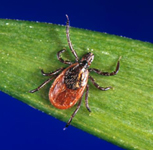Lyme Disease: Overview
Posted by: Diagnosis.com
Category: Lyme Disease
 Lyme disease is caused by the bacterium Borrelia burgdorferi and is transmitted to humans by the bite of infected blacklegged ticks. Typical symptoms include fever, headache, fatigue, and a characteristic skin rash called erythema migrans. If left untreated, infection can spread to joints, the heart, and the nervous system. Lyme disease is diagnosed based on symptoms, physical findings (e.g., rash), and the possibility of exposure to infected ticks; laboratory testing is helpful in the later stages of disease.
Lyme disease is caused by the bacterium Borrelia burgdorferi and is transmitted to humans by the bite of infected blacklegged ticks. Typical symptoms include fever, headache, fatigue, and a characteristic skin rash called erythema migrans. If left untreated, infection can spread to joints, the heart, and the nervous system. Lyme disease is diagnosed based on symptoms, physical findings (e.g., rash), and the possibility of exposure to infected ticks; laboratory testing is helpful in the later stages of disease.
If left untreated, infection can spread to joints, the heart, and the nervous system. Lyme disease is diagnosed based on symptoms, physical findings (e.g., rash), and the possibility of exposure to infected ticks; laboratory testing is helpful in the later stages of disease.
Most cases of Lyme disease can be treated successfully with a few weeks of antibiotics. Steps to prevent Lyme disease include using insect repellent, removing ticks promptly, landscaping, and integrated pest management. The ticks that transmit Lyme disease can occasionally transmit other tick-borne diseases as well.
Source: CDC
where is lyme disease located at?
Lyme disease was originally named for the town of Lyme, Connecticut, where in the 1970’s a mysterious clustering of juvenile rheumatoid arthritis cases were documented. The cases were later traced to tiny deer ticks in the surrounding wooded areas.
In a 2005 report on Lyme Disease (PDF), the U.S. Department of Health and Human Services indicates that, while Lyme Disease has been reported in nearly all states in the United States, “more than 95 percent of all reported cases are concentrated in the coastal Northeast, mid-Atlantic states, Wisconsin, Minnesota, and northern California.”
Is there any sweating, swelling, dizziness involved? If itsn’t treated within a month, could you die from it?